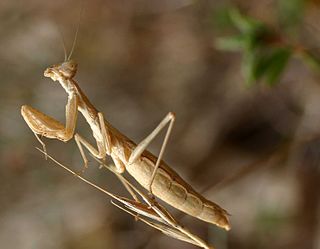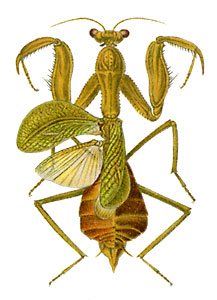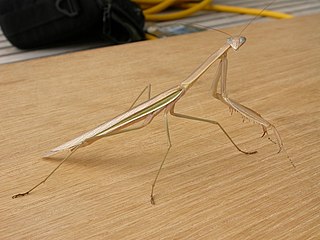
The Chinese mantis is a species of mantis native to Asia and the nearby islands. In 1896, this species was accidentally introduced by a nursery tender at Mt. Airy near Philadelphia, United States. Tenodera sinensis often is erroneously referred to as Tenodera aridifolia sinensis because it was at first described as a subspecies of Tenodera aridifolia, but Tenodera sinensis is now established as a full species.

Mantidae is one of the largest families in the order of praying mantises, based on the type species Mantis religiosa; however, most genera are tropical or subtropical. Historically, this was the only family in the order, and many references still use the term "mantid" to refer to any mantis. Technically, however, "mantid" refers only to members of the family Mantidae, and not the 14 remaining families of mantises. Some of the most recent classifications have promoted a number of the mantid subfamilies to the rank of family, e.g. Iridopterygidae, Sibyllidae, Tarachodidae, Thespidae, and Toxoderidae, while other classifications have reduced the number of subfamilies without elevating them to higher rank.

Tenodera is a genus of mantis in the family Mantidae which contains several species of praying mantises. The species in this genus can be found primarily in Africa, Asia and Australia, but also North America.

Iris oratoria, known by the common name Mediterranean mantis, due to humans first studying it in lands around the Mediterranean Sea, is a species of praying mantis. Its range is expanding in the Middle East, Western Asia and the United States.

Archimantis latistyla, commonly known as the large brown mantis is a species of mantid native to Australia. The large brown mantis has two subspecies, a widespread subspecies and the stick mantis ghost from Bundabergs Turtle Sands. The stick mantis ghosts are not as aggressive as the widespread species but have a defense display used to make the mantis appear larger by flinging its front legs into the air and putting its head down along with its antennae. Large brown mantids are light brown with short winged female and a long winged male. The subspecies from Bundaberg is a pale cream white with a yellow and black eye in between the arms. The large brown mantis female is short winged - her wings reach only half her abdomen and she is not able to fly— but the long winged male has wings that cover the entire abdomen. They have two pairs of wings - the top pair are the wing covers and the bottom wings enable the mantis to fly.

Ameles decolor is a species of small praying mantis native to the west Mediterranean and North Africa. A. decolor was first described by entomologist Domenico Cyrillo in 1787, and its current classification was established in 1976 by Karl Harz and Alfred Peter Kaltenbach. A. decolor presents as a small, light brown mantis with females tending to appear larger than their male counterparts. The mating patterns of A. decolor are considered some of the most complex amongst praying mantises, with males presenting two different styles of courtship. Their habitat favours shrublands, grasslands, and wooded areas.

Cilnia humeralis, common name wide-armed mantis, is an aggressive and very cannibalistic species of praying mantis from Africa.

Acromantis japonica, common name Japanese boxer mantis, is a species of praying mantis found in Japan, Korea, Taiwan, and China. It was described by John Obadiah Westwood in 1889. Acromantis japonica belongs to the family Hymenopodidae and subfamily Acromantinae. No subspecies are listed.

Tenodera australasiae, the purple-winged mantis, is species of praying mantis. Found throughout Australia, it is common in the eastern regions. Both males and females are capable of flight. The species has not been shown to be parthenogenetic.

Hierodula tenuidentata is a species of praying mantis, sharing its common name giant Asian mantis with other large members of genus Hierodula in the family Mantidae. It is native to India, and has been introduced to Greece and elsewhere in southern Europe, including Hungary, Romania, and Serbia.

Empusa fasciata is a species of praying mantis in the genus Empusa in the order Mantodea.

Rivetina is a genus of praying mantises in the family Rivetinidae.

Mantises are an order (Mantodea) of insects that contains over 2,400 species in about 460 genera in 33 families. The largest family is the Mantidae ("mantids"). Mantises are distributed worldwide in temperate and tropical habitats. They have triangular heads with bulging eyes supported on flexible necks. Their elongated bodies may or may not have wings, but all Mantodea have forelegs that are greatly enlarged and adapted for catching and gripping prey; their upright posture, while remaining stationary with forearms folded, has led to the common name praying mantis.

Tenodera aridifolia, the Japanese giant mantis, is a species of mantis in the subfamily Mantinae. The Chinese mantis, T. sinensis, was once considered to be a subspecies of T. aridifolia, but the species can be distinguished by the shape of male genitalia.
Tenodera parasinensis is a species of praying mantis.
Tenodera superstitiosa is a species in the family Mantidae.
Tenodera acuticauda is a species of mantis in the family Mantidae.














